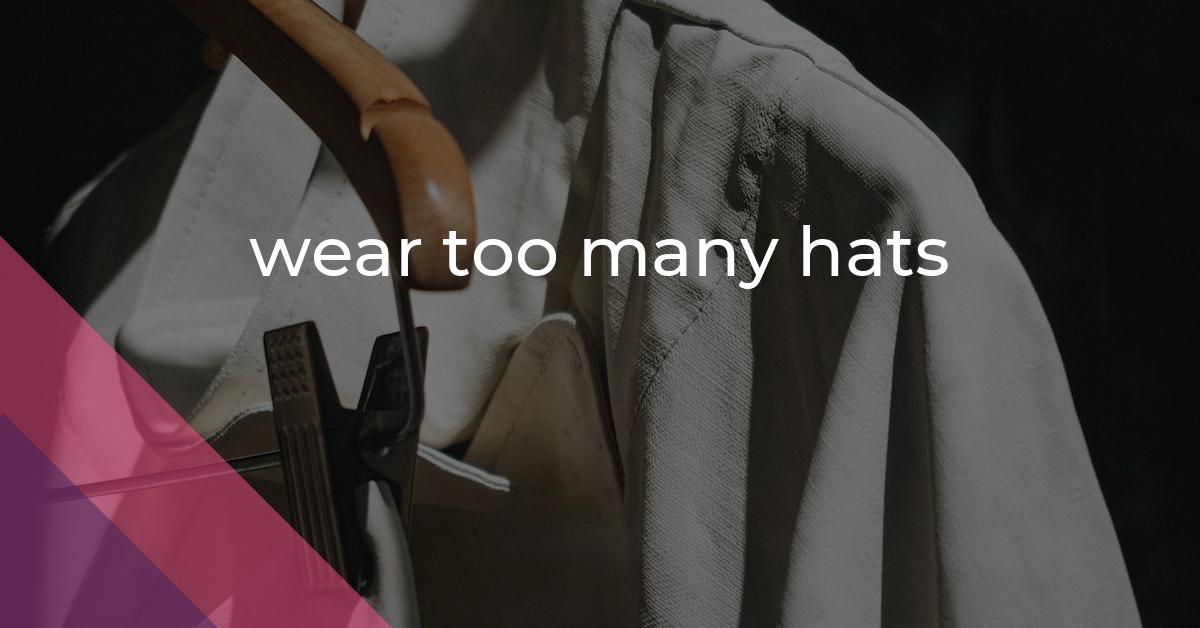wear too many hats: Idiom Meaning and Origin
What does ‘wear too many hats’ mean?
The idiom "wear too many hats" means to take on multiple roles or responsibilities, often to an excessive or overwhelming extent, resulting in a lack of focus or effectiveness. It suggests a person taking on more tasks than they can effectively handle.

Idiom Explorer
The idiom "wear thin" means to gradually lose one's patience, endurance, or tolerance towards something or someone. It implies that the situation or person is becoming annoying, irritating, or tiresome over time.
The idiom "wear the trousers" means to be the dominant or controlling person in a relationship or situation.
The idiom *too many balls in the air* means having too many tasks or responsibilities to handle at once, often leading to feelings of overwhelm or a lack of focus and organization.
The idiom "too clever by half" means being excessively confident or overestimating one's own abilities, resulting in mistakes or unfavorable outcomes.
The idiom "too big for one's britches" means to be overly confident or arrogant, behaving as if one is more important or capable than they actually are.
"Too big for one's boots" means to have an exaggerated sense of one's own importance or ability. It implies that someone thinks they are more powerful or skilled than they actually are, leading to arrogance or overconfidence.
The idiom "snowed under" means to be overwhelmed or flooded with too much work or responsibilities.
The idiom "put a hat on a hat" means to make a situation or an idea unnecessarily complicated or redundant by adding extra layers or elements.
The idiom "over one's head" means to be too difficult or complex for someone to understand or comprehend.
The idiom "one too many" means to have or consume more of something than is considered acceptable or appropriate.
Juggling Identities
The idiom "wear too many hats" is commonly used in American English and has a figurative meaning. It is derived from the literal act of wearing multiple hats, which suggests the idea of taking on multiple roles or responsibilities simultaneously. When someone is said to "wear too many hats," it implies that they are juggling numerous tasks or duties, often more than they can effectively manage. This idiom conveys a sense of overwhelm or being spread too thin.
Similar to "wear too many hats," the idiom "too many balls in the air" is another expression often used to describe the situation when someone has taken on an excessive number of tasks or responsibilities. This idiom conveys the visual image of someone juggling multiple balls, symbolizing the need to constantly keep things in motion. When a person has "too many balls in the air," it suggests that they are at risk of dropping one or more of the tasks or responsibilities they are trying to manage. This idiom emphasizes the idea that having too much on one's plate can lead to a lack of focus and potential mistakes.
Another related idiom is "one too many," which is often used to describe a situation where someone has taken on one task or responsibility too many. This expression conveys the idea that there is a tipping point or limit to how much one can effectively handle. When a person has "one too many" tasks or responsibilities, it suggests that they are already stretched thin and taking on any additional tasks would push them beyond their capacity. This idiom highlights the importance of recognizing one's limits and avoiding the temptation to take on more than can be managed.
Similarly, the idiom "put a hat on a hat" is another expression that relates to the concept of wearing too many hats. This idiom refers to the act of adding an unnecessary or redundant layer or element to something that is already complex or crowded. In the context of taking on multiple roles or responsibilities, "putting a hat on a hat" implies that someone is adding yet another task or responsibility to an already overwhelming workload. This idiom emphasizes the need to simplify and prioritize, rather than adding unnecessary complexity.
By using the idiom "wear too many hats," speakers are able to succinctly convey the idea of someone taking on excessive tasks or roles, often implying a negative consequence such as being overworked, having a lack of focus, or being unable to perform well in any specific area. This idiom is commonly used in both informal and formal contexts, including everyday conversations, workplace discussions, and professional writing.
The idiom "too many balls in the air" provides an additional layer of imagery to this concept. It suggests that the person who is juggling multiple tasks or responsibilities is at risk of dropping one or more of them, leading to potential mistakes or failures. This idiom emphasizes the need to be careful and prioritize tasks effectively to avoid losing control. It highlights the challenge of managing a wide range of tasks simultaneously.
Similarly, the idiom "one too many" draws attention to the importance of recognizing personal limits. Taking on one task or responsibility too many can push an individual past their capacity, leading to stress, burnout, and a decline in overall performance. This idiom encourages individuals to be mindful of their own capabilities and to refrain from overstretching themselves.
Additionally, the idiom "put a hat on a hat" reminds individuals to avoid adding unnecessary complexity to their workload. Taking on an excess of tasks or responsibilities can lead to inefficiency and confusion, as well as a diminished ability to perform well in any specific area. This idiom encourages individuals to simplify and streamline their workload, focusing on what is essential and removing unnecessary layers.
Furthermore, the idiom "wear too many hats" can also be seen as a reflection of the modern multitasking culture, where individuals are often expected to handle multiple responsibilities simultaneously. In an increasingly fast-paced and demanding world, the pressure to "wear too many hats" can result in stress, burnout, and a decline in overall productivity.
It is important to note that the idiom "wear too many hats" does not necessarily imply that taking on multiple roles or responsibilities is inherently negative. In certain situations, being able to effectively manage various tasks and adapt to different roles can be seen as a valuable skill. However, when the idiom is used, it often carries a connotation of overwhelm or imbalance, suggesting that the person in question is struggling to handle the demands of their various roles effectively.
The idiom "wear too many hats" is a widely used expression in American English to describe the act of taking on numerous roles or responsibilities. Its figurative meaning conveys a sense of overwhelm and suggests that the person is juggling more tasks than they can effectively manage. While the exact origin of the idiom remains uncertain, it is rooted in the literal act of physically wearing multiple hats. This idiom reflects the pressures of a multitasking culture and is often used to discuss the negative consequences of spreading oneself too thin. However, it is important to recognize that taking on multiple roles can also be seen as a valuable skill when managed effectively.
Example usage
Examples of how the idiom "wear too many hats" can be used in a sentence:
- He is the CEO of the company, but he also handles the finance, marketing, and HR departments. He wears too many hats.
- As a teacher, she not only teaches English but also coaches the basketball team and organizes school events. She wears too many hats.
- John is a software developer, but he also takes on the role of project manager, designer, and tester. He wears too many hats.
More "Multitasking" idioms



